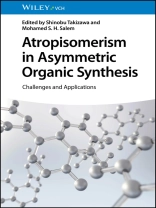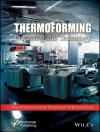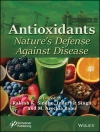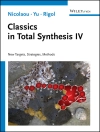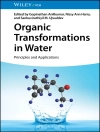Unique overview of the recent synthetic methodologies of the atropisomeric molecules and their numerous practical applications
Atropisomerism in Asymmetric Organic Synthesis: Challenges and Applications presents new methodologies, strategies, unique catalysts, and solutions to challenges in the area of oxidative heterocoupling. After a general introduction for the concept of atropisomerism, this book focuses on the recent advances in the atroposelective synthesis of axially chiral compounds and how these advances had a significant impact on several applications in asymmetric catalysis and the synthesis of natural products.
The book covers the recent examples of metal-catalyzed (Cu, Fe, Ru, V, etc) and organocatalyzed atroposelective syntheses of axially chiral compounds using diverse approaches, including cross-coupling reactions, ring-opening reactions, formation of new aromatic rings, and desymmetrization via functional group transformation. The impact of these efficient strategies on various applications in asymmetric catalysis, total synthesis of natural products, synthesis of polycyclic heteroaromatics (PHAs), and the drug industry is also addressed.
Edited by two highly qualified academics, Atropisomerism in Asymmetric Organic Synthesis explores sample topics including:
- Iron- and ruthenium-catalyzed atroposelective synthesis of axially chiral compounds and the catalytic applications of multinuclear zinc complexes with axially chirality
- Vanadium-catalyzed atroposelective coupling of arenols and application in the synthesis of polycyclic heteroaromatics PHAs
- Mechanisms of atroposelective Suzuki-Miyaura coupling towards axially chiral biaryls and organocatalytic enantioselective formation of atropisomers
- Synthesis of atropisomers via enantioselective ring-opening reactions and the impact of axially chiral ligands and catalysts derived from atropisomeric binaphthyl structures
- Binaphthyl-based chiral DMAP derivatives in enantioselective transformations and catalytic atroposelective oxidative coupling in natural product synthesis
Enabling readers to comprehensively understand the development history, research status, and potential of atropisomeric synthesis, Atropisomerism in Asymmetric Organic Synthesis is an essential, up-to-date reference for researchers and scientists in the field.
Mục lục
Preface xiii
About the Editors xv
Part I Atroposelective Synthesis 1
1 Introduction 3
Mohamed S. H. Salem and Shinobu Takizawa
1.1 Molecular Chirality and Atropisomerism 3
1.2 Atropisomerism in Asymmetric Organic Synthesis 6
1.3 Atropisomerism: Challenges and Applications 10
References 16
2 Iron- and Ruthenium-Catalyzed Atroposelective Synthesis of Axially Chiral Compounds 21
Tatsuya Uchida
2.1 Introduction 21
2.2 Oxidative Homo-coupling of 2-Naphthols to BINOL and Its Derivatives 22
2.3 Oxidative Cross-coupling of 2-Naphthols to Asymmetric BINOLs 29
2.4 Oxidative Spirocyclization of 2-Naphthols 38
2.5 Conclusion 41
References 42
3 Vanadium-Catalyzed Atroposelective Coupling of Arenols and Application in the Synthesis of Polycyclic Heteroaromatics (PHAs) 45
Mohamed S. H. Salem and Shinobu Takizawa
3.1 Introduction 45
3.2 Chiral Vanadium Catalysis in Homo-Coupling of Hydroxycarbazoles 47
3.3 Chiral Vanadium Catalysis in Hetero-Coupling of Hydroxycarbazole with 2-Naphthols 50
3.4 Enantioselective Synthesis of Oxa[9]helicenes via Chiral Vanadium Complex-Catalyzed Homo-Couplings of Polycyclic Phenols 55
3.5 Enantioselective Synthesis of Oxaza[7]dehydrohelicenes via Chiral Vanadium Complex-Catalyzed Hetero-Couplings of
3-Hydroxycarbazoles and 2-Naphthols 58
3.6 Summary and Conclusion 62
References 63
4 Atroposelective Suzuki–Miyaura Coupling Toward Axially Chiral Biaryls: Mechanistic Insight 69
Toshinobu Korenaga
4.1 Introduction 69
4.2 Mechanism Insight of SMC Reaction and Enantiodetermining Step 70
4.3 Asymmetric SMC Reaction 72
4.4 Conclusion 85
References 85
5 Organocatalytic Enantioselective Formation of Atropisomers 91
Chiara Portolani, Giovanni Centonze, and Giorgio Bencivenni
5.1 Introduction 91
5.2 Aminocatalysis 92
5.3 Brønsted Base Catalysis 99
5.4 Phase Transfer Catalysis 112
5.5 Chiral Phosphoric Acids 120
5.6 Conclusions 131
References 132
6 Synthesis of Atropisomers via Enantioselective Ring-Opening Reactions 137
Longhui Duan and Zhenhua Gu
6.1 Introduction 137
6.2 Asymmetric Ring Opening of Biaryl Lactones and Their Derivatives 137
6.3 Asymmetric Ring-Opening Reactions via C—I Bond Cleavage 145
6.4 Asymmetric Ring-Opening Reactions via C—N and C—P Bonds Cleavage 153
6.5 Asymmetric Ring-Opening Reactions via C—C and C—Si Bond Cleavage 155
6.6 Asymmetric Ring-Opening Reactions via C—O and C—S Bond Cleavage 159
6.7 Oriented Asymmetric Ring Opening via Transient Pentacyclic Metal Species 162
6.8 Summary and Conclusions 164
References 164
Part II Challenges and Applications 171
7 Axially Chiral Ligands and Catalysts Derived from Atropisomeric Binaphthyl Structures 173
Shouyi Cen and Zhipeng Zhang
7.1 Introduction 173
7.2 Chiral Ligands Derived from BINOLs 174
7.3 Chiral Ligands Derived from BINAMs 185
7.4 Chiral Ligands Derived from NOBINs 187
7.5 Chiral Organocatalysts Derived from BINOLs 189
7.6 Chiral Organocatalysts Derived from BINAMs 197
7.7 Chiral Organocatalysts Derived from NOBINs 199
7.8 Chiral Ligands and Catalysts Derived from Other Binaphthyl Motifs 199
7.9 Summary and Outlook 201
References 202
8 Multinuclear Zinc Catalysts with Axial Chirality 219
Takayoshi Arai
8.1 Pioneering Works on BINOL-Zn System 219
8.2 Enantioselective Addition Reaction of Dialkylzinc to Aldehydes Using BINOL Additive 219
8.3 Catalytic Asymmetric Alkynylation of Aldehydes 223
8.4 Catalytic Asymmetric Diels–Alder Reaction 224
8.5 Catalytic Asymmetric Epoxidation of Enones 225
8.6 Catalytic Asymmetric Direct Aldol Reaction 226
8.7 Catalytic Asymmetric Iodofunctionalization of Alkenes 230
8.8 Conclusions 233
References 233
9 Binaphthyl-Based Chiral DMAP Derivatives in Enantioselective Transformations 237
Hiroki Mandai and Seiji Suga
9.1 Introduction 237
9.2 Binaphthyl-Based Chiral DMAP Derivatives 240
9.3 Intramolecular Acyl Transfer Reactions 242
9.4 Intermolecular Acyl Transfer Reactions 247
9.5 Summary and Conclusions 260
References 261
10 Catalytic Atroposelective Oxidative Coupling in Natural Product Synthesis 267
Houng Kang and Marisa C. Kozlowski
10.1 Introduction 267
10.2 Copper-Catalyzed Asymmetric Oxidative Coupling to Construct a Chiral Axis 273
10.3 Vanadium-Catalyzed Asymmetric Oxidative Coupling to Construct a Chiral Axis 283
10.4 Enzymatic Strategies to Synthesize Natural Products via Atroposelective Coupling 295
10.5 Conclusion 297
References 298
11 Atropisomerism in Drug Discovery and Development 309
Khaled M.Darwish, Asmaa S.A.Yassen, Ebtehal M.Husseiny, Mohammed I. A. Hamed, and Mohamed A. Helal
11.1 Introduction 309
11.2 Configuration Assignment of Atropisomeric Drugs 309
11.3 Classification of Atropisomeric Drugs According to the Rotational Energy Barrier 310
11.4 Analysis of Atropisomeric Drugs Across the Pharmaceutical Market 311
11.5 Introducing Atroisomerism to Modulate Selectivity 320
11.6 Challenges for Atropisomerism within Drug Discovery 323
11.7 Conclusion 326
References 326
Index 331
Giới thiệu về tác giả
Shinobu Takizawa, Ph D, is Professor at SANKEN, Osaka University, Japan. His current research focuses on developing environmentally friendly organic synthetic processes.
Mohamed S. H. Salem, Ph D, is Assistant Professor at SANKEN, Osaka University, Japan. His current research focuses on developing green synthetic approaches for the bottom-up synthesis of functionalized small organic molecules with various material-based applications.
